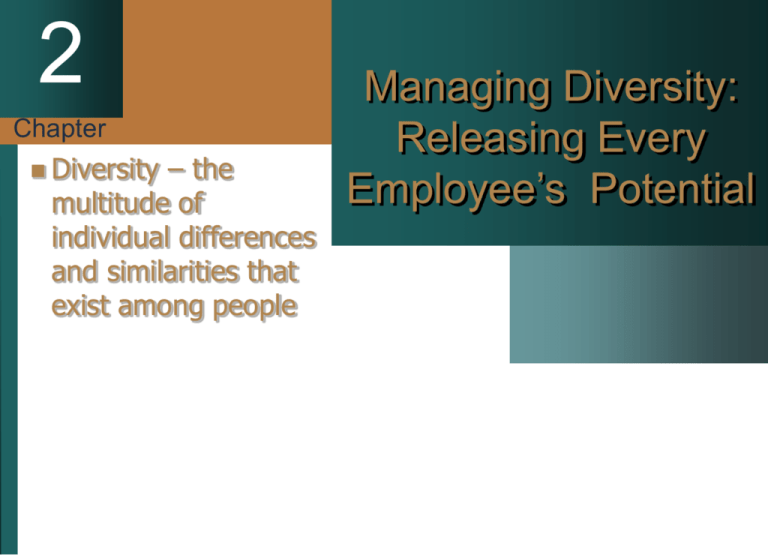
2
Chapter
Diversity
– the
multitude of
individual differences
and similarities that
exist among people
Managing Diversity:
Releasing Every
Employee’s Potential
2-2
The Four Layers of Diversity
Figure 2-1
Functional Level/
Classification
Geographic Location
Mgmt.
Status
Marital
Status
Parental
Status
Age
Income
Work
Content/
Field
Personal
Habits
Race
Personality
Appearance
Union
Affiliation
Ethnicity
Work
Experience
Work
Location
McGraw-Hill
Sexual
Orientation
Physical
Ability
Recreational
Habits
Religion
Educational
Background
Division/
Dept./
Unit/
Group
Source: L Gardenswartz
and A Rowe, Diverse
Teams
at Work: Capitalizing on
the Power of Diversity
(New
York: McGraw-Hill,
1994), p. 33
Seniority
© 2004 The McGraw-Hill Companies, Inc. All rights reserved.
2-3
Affirmative Action, Valuing Diversity,
and Managing Diversity
Affirmative Action
Valuing Diversity
Managing Diversity
Quantitative
Qualitative
Behavioral
Legally Driven
Ethically Driven
Strategically Driven
Remedial
Idealistic
Pragmatic
Assimilation Model
Diversity Model
Synergy Model
Opens Doors in the
Organization
Opens Attitudes, Minds,
and the Culture
Opens the System
McGraw-Hill
Table 2-1
© 2004 The McGraw-Hill Companies, Inc. All rights reserved.
2-4
Affirmative Action, Valuing Diversity,
and Managing Diversity
Affirmative Action
Resistance Due to
Perceived Limits to
Autonomy in Decision
Making and Perceived
Fears of Reverse
Discrimination
McGraw-Hill
Valuing Diversity
Resistance Due to Fear
of Change, Discomfort
with Differences, and
Desire for Return to
“Good Old Days”
Table 2-1 Cont.
Managing Diversity
Resistance Due to Denial
of Demographic
Realities, the Needs for
Alternative Approaches,
and/or Benefits
Associated with Change;
and the Difficulty in
Learning New Skills,
Altering Existing
Systems, and/or Finding
Time to Work Toward
Synergistic Solutions
© 2004 The McGraw-Hill Companies, Inc. All rights reserved.
2-5
Workforce Demographics
Table 2-2 Cont.
Percent Entrants
2000-2010
Percent Departures
2000-2010
100.0
49.6
50.4
100.0
55.4
44.6
White Non-Hispanic
60.6
77.4
African-American
13.7
11.8
Hispanic
17.9
7.2
7.8
3.6
Total
Men
Women
Asian and Other Races
McGraw-Hill
© 2004 The McGraw-Hill Companies, Inc. All rights reserved.
The Glass Ceiling
Invisible
barrier preventing women and minorities
from advancing to top management
Women
Earn ~76% of what men earn in U.S.
Do not equal men in pay or position in any country in the
world
Hold only 2% of senior management positions
Minorities
African American men earn ~71% of what white American
men earn
African American women earn ~64% of what white
American men earn
2-6
Women’s explanation for the Glass Ceiling
Male stereotyping,
preconceptions and exclusion
from informal networks
1.
McGraw-Hill
© 2004 The McGraw-Hill Companies, Inc. All rights reserved.
What research shows
Effect
of men
Stereotypical
beliefs
Fear of losing power or of change
Effect
of women
Human
capital
Stereotypical beliefs
2-7
Women’s strategies to further advancement
1.
Consistently exceeding
performance expectations
2. Developing a style with which
male managers are comfortable
3. Seeking difficult or challenging
assignments
4. Having influential mentors
McGraw-Hill
© 2004 The McGraw-Hill Companies, Inc. All rights reserved.
2-8
Underemployment
Underemployment the
result of taking a job that
requires less education,
training or skills than
possessed by a worker
Negatively related to:
Job satisfaction,
psychological well-being
Positively related to:
McGraw-Hill
Arrest rates
Likelihood of becoming
young, unmarried
parent
Absenteeism and
turnover
© 2004 The McGraw-Hill Companies, Inc. All rights reserved.
2-11
Competitive Advantage of Managing Diversity
Lower Costs and Improved Employee
Attitudes
Improved Recruiting Efforts
Increased Sales, Market Share, and Corporate
Profits
Increased Creativity and Innovation
Increased Group Problem Solving and
Productivity
McGraw-Hill
© 2004 The McGraw-Hill Companies, Inc. All rights reserved.
Barriers to Managing Diversity
Inaccurate
stereotypes & prejudice
Ethnocentrism
An unsupportive and hostile working
environment
Fears of reverse discrimination
Diversity not seen as organizational priority
Resistance to change
Specific initiatives to improve diversity
management
– managers’ responsibility to treat
diverse employees fairly
Development practices – prepare diverse employees
for greater responsibility and advancement
Recruitment practices – attracting all levels of
qualified job applicants who are willing to accept
challenging work assignments
Accountability






